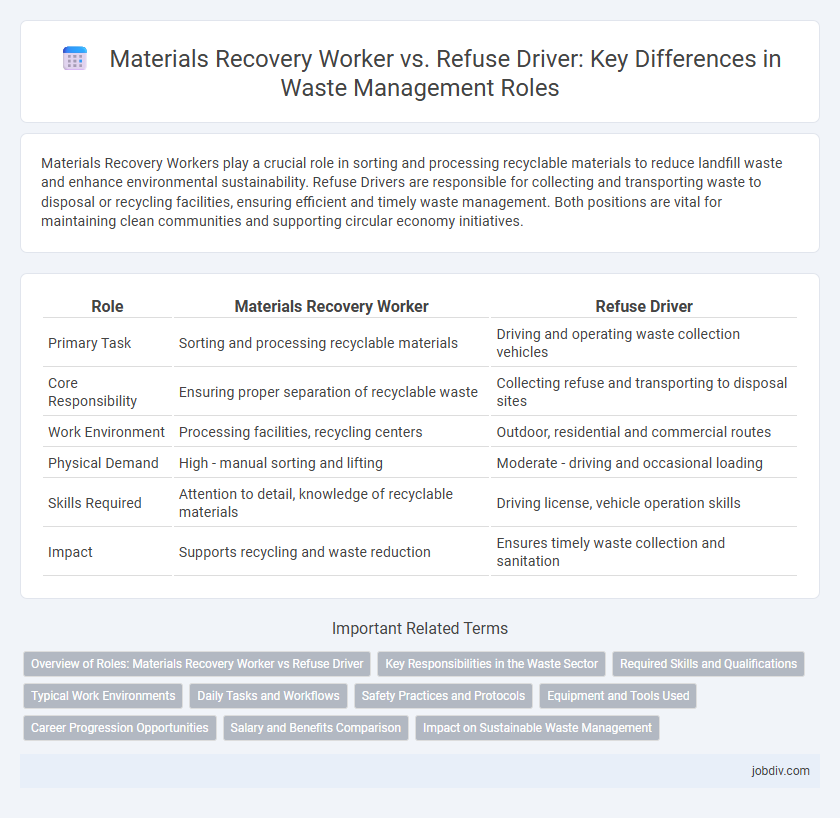Materials Recovery Workers play a crucial role in sorting and processing recyclable materials to reduce landfill waste and enhance environmental sustainability. Refuse Drivers are responsible for collecting and transporting waste to disposal or recycling facilities, ensuring efficient and timely waste management. Both positions are vital for maintaining clean communities and supporting circular economy initiatives.
Table of Comparison
| Role | Materials Recovery Worker | Refuse Driver |
|---|---|---|
| Primary Task | Sorting and processing recyclable materials | Driving and operating waste collection vehicles |
| Core Responsibility | Ensuring proper separation of recyclable waste | Collecting refuse and transporting to disposal sites |
| Work Environment | Processing facilities, recycling centers | Outdoor, residential and commercial routes |
| Physical Demand | High - manual sorting and lifting | Moderate - driving and occasional loading |
| Skills Required | Attention to detail, knowledge of recyclable materials | Driving license, vehicle operation skills |
| Impact | Supports recycling and waste reduction | Ensures timely waste collection and sanitation |
Overview of Roles: Materials Recovery Worker vs Refuse Driver
Materials Recovery Workers sort and process recyclable materials at recovery facilities, ensuring proper separation of plastics, metals, paper, and glass to maximize recycling efficiency. Refuse Drivers collect and transport waste and recyclables from residential, commercial, and industrial sites to disposal or processing centers, operating specialized vehicles and adhering to safety protocols. Both roles are essential in waste management, contributing to environmental sustainability through efficient waste collection and material recovery.
Key Responsibilities in the Waste Sector
Materials Recovery Workers focus on sorting and separating recyclable materials from waste streams to ensure efficient recycling processes and reduce landfill impact. Refuse Drivers are responsible for operating waste collection vehicles, managing waste pick-up routes, and ensuring timely and safe transport of waste to disposal or recycling facilities. Both roles are critical in maintaining effective waste management systems and supporting environmental sustainability efforts.
Required Skills and Qualifications
Materials Recovery Workers require strong sorting and identification skills, knowledge of recycling processes, and physical stamina to handle various recyclable materials efficiently. Refuse Drivers must possess a valid commercial driver's license (CDL), excellent driving skills, and the ability to operate refuse collection vehicles safely and efficiently. Both roles demand teamwork, safety awareness, and a commitment to environmental regulations and waste management standards.
Typical Work Environments
Materials Recovery Workers primarily operate in recycling centers and sorting facilities where they handle recyclable materials to ensure proper processing. Refuse Drivers work mainly in outdoor environments, including residential and commercial collection routes, managing waste collection vehicles. Both roles demand adherence to safety standards, but Materials Recovery Workers generally experience more indoor, climate-controlled settings compared to the dynamic outdoor conditions faced by Refuse Drivers.
Daily Tasks and Workflows
Materials Recovery Workers primarily sort and separate recyclable materials such as plastics, metals, and paper at processing facilities to ensure proper recycling and waste reduction. Refuse Drivers operate collection vehicles, navigate assigned routes to pick up residential and commercial waste, and ensure timely delivery to disposal or sorting centers. Both roles require adherence to safety protocols and efficient handling of waste but differ in onsite processing versus logistical collection tasks.
Safety Practices and Protocols
Materials Recovery Workers strictly follow sorting protocols and wear protective gear such as gloves, helmets, and high-visibility vests to minimize injury risks from sharp or hazardous waste. Refuse Drivers adhere to rigorous vehicle operation procedures, including regular equipment checks and safe loading techniques to prevent accidents during waste collection routes. Both roles prioritize adherence to OSHA regulations and continuous safety training to maintain a secure working environment.
Equipment and Tools Used
Materials Recovery Workers primarily use sorting conveyors, magnetic separators, and air classifiers to efficiently separate recyclable materials from waste streams. Refuse Drivers rely on heavy-duty refuse trucks equipped with hydraulic lifts, compactors, and automated loading arms for efficient waste collection and transportation. The specialized equipment ensures optimal material processing in recovery facilities versus streamlined waste disposal during collection routes.
Career Progression Opportunities
Materials Recovery Workers often gain hands-on experience in sorting and processing recyclable materials, which can lead to specialization roles such as equipment operation or quality control within recycling facilities. Refuse Drivers acquire skills in vehicle operation, route management, and team coordination, positioning them for advancement to supervisory or fleet management roles in waste collection services. Both career paths offer opportunities to progress into environmental compliance or waste management planning, leveraging their operational expertise in the broader waste management industry.
Salary and Benefits Comparison
Materials Recovery Workers typically earn an average hourly wage of $15 to $22, reflecting their specialized role in sorting recyclable materials, while Refuse Drivers have a higher average hourly wage range of $18 to $28, driven by their responsibility for operating heavy vehicles and managing waste collection routes. Benefits for both positions often include health insurance, retirement plans, and paid time off, but Refuse Drivers may receive additional incentives such as hazard pay and overtime bonuses due to the physical demands and risk factors of their job. Salary and benefits vary by location, experience, and employer, with unionized workers generally securing better compensation packages in both roles.
Impact on Sustainable Waste Management
Materials Recovery Workers play a crucial role in sustainable waste management by sorting recyclable materials from waste streams, thereby reducing landfill volumes and promoting the circular economy. Refuse Drivers contribute by efficiently collecting and transporting waste to appropriate disposal or processing facilities, ensuring timely waste removal and minimizing environmental hazards. Together, these roles enhance resource recovery rates, limit greenhouse gas emissions, and support the overall sustainability of waste management systems.
Materials Recovery Worker vs Refuse Driver Infographic

 jobdiv.com
jobdiv.com